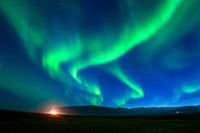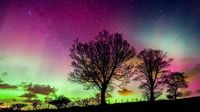The Northern Lights, or aurora borealis, made a rare and dazzling appearance across the United Kingdom and much of Europe and North America in early September 2025, delivering a celestial spectacle that left stargazers and sky-watchers in awe. From the rugged coasts of northern Scotland to the urban landscapes of Kent, and as far afield as Slovakia, Denmark, and Canada, the skies shimmered with vibrant greens, pinks, reds, and violets—a result of a powerful solar storm that swept across the globe.
According to the Met Office, the phenomenon began late on Monday, September 1, 2025, when a fast-moving coronal mass ejection (CME) released from the Sun’s corona late on Saturday night, August 30, slammed into Earth’s magnetic field. This event, described by experts as a “cannibal CME”—where one ejection overtakes another, creating an even more potent disturbance—sparked a geomagnetic storm that reached G2 (moderate) levels, as confirmed by both the U.K. Met Office and NOAA’s Space Weather Prediction Center. Forecasts even hinted at the possibility of G3 or G4 (severe) activity, raising hopes for an even more dramatic display.
The CME’s arrival was dramatic. Solar wind speeds leapt to over 670 kilometers per second, and the interplanetary magnetic field intensified to between 20 and 26 nanotesla. Yet, as solar physicist Tamitha Skov wrote on X, “As we suspected the #solarstorm has made a strong entrance, but it is oriented the wrong way.” The north-south magnetic orientation, known as Bz, stubbornly stayed northward for much of the event, which limited how much energy could couple into Earth’s magnetosphere. Despite this, bursts of activity provided ample opportunity for sky-watchers to catch the aurora, especially in northern latitudes.
“There is a chance aurora may be visible across much of the UK,” the Met Office announced, noting that such displays visible to the naked eye are “relatively rare for locations this far south in the UK.” The Met Office’s Krista Hammond added, “While the best views are likely further north, anyone with clear, dark skies should keep an eye out. Forecasts can change rapidly, so we encourage the public to stay updated with the latest information.”
Indeed, millions of Britons had a shot at witnessing the aurora, with the best conditions in north-east Scotland, northern England, and the Midlands. Clear, dark skies were crucial, as light pollution and cloud cover could easily spoil the view—especially for those in more southern or urban areas. The Met Office also warned that a waxing gibbous moon could further disrupt visibility, particularly where additional artificial light was present.
What causes this otherworldly display? The answer lies in the Sun’s restless activity. The aurora borealis is the result of interactions between the solar wind—a stream of charged particles emitted by the Sun—and Earth’s magnetic field and atmosphere. These particles, traveling at speeds around a million miles per hour, are funneled into the atmosphere near the magnetic poles when the magnetic polarity of the solar wind opposes that of Earth’s field. Once inside the upper atmosphere, these energetic particles collide with gas molecules such as oxygen and nitrogen, exciting them and causing them to emit light. Green, the most common auroral color, is produced by oxygen molecules about 60 miles up, while rarer reds and violets emerge at higher altitudes, courtesy of oxygen and nitrogen, respectively.
For many, this was a once-in-a-lifetime experience. Social media buzzed with excitement as photographers and aurora chasers shared images and stories from across the UK and beyond. Stevo Howells captured the moment from Hopeman, Scotland, exclaiming, “Wow, the sky just lit up pink and green—filmed it live on my phone.” In Northumberland, Julie Winn reported, “Headed out to find clear sky after the initial shock, had a wonderful visual eyeball by 12:30 a.m. BST. We then waited it out, hoping for another drop in Bz, which didn’t come, but had bright pink on camera right through till 4 a.m.”
Photographer Paul Appleby celebrated, “Well, that’s the first one of the season in the bag. Lovely show of Aurora Borealis at St. Mary’s Lighthouse tonight.” Meanwhile, stunning colors were spotted as far south as Slovakia, and Denmark saw its own vibrant display around 1:25 a.m. local time on September 2. In France, Alexis Linant captured the show above Puy de Dôme, observing, “Nothing exceptional due to a Bz way too oscillating unfortunately, too bad, it was starting off pretty well!”
Across the Atlantic, the spectacle was just as impressive. In Grand Bend, Ontario, Canada, Jamie posted a timelapse of the northern lights dancing in the night sky. Greg Gage in Sistersville, West Virginia, described, “Labor Day ended with an auroral display here… the aurora was low on the horizon with nice pastel pinks. The display only lasted about half an hour.” Leah Howard, flying just south of Pittsburgh, U.S., wrote, “Extraordinary view of the aurora tonight flying just south of Pittsburgh!”
Despite the storm’s orientation limiting the event’s severity, the widespread visibility and vibrant colors made it a memorable occurrence. The Met Office cautioned that by Wednesday, September 3, solar activity would likely return to normal levels, and the aurora’s visibility would diminish. Cloud cover and the waxing gibbous moon were expected to further reduce the chances of sightings as the week progressed.
As with all natural spectacles, timing and luck played a role. Those who braved the late hours and sought out dark, clear skies were rewarded with a show that, for many, will remain unforgettable. The event served as a reminder of the dynamic relationship between our planet and its star, and the awe-inspiring beauty that can arise when the heavens align just so.
For those who missed it, experts recommend keeping an eye on space weather forecasts. As solar activity waxes and wanes, more opportunities for auroral displays may arise—though, as this week proved, predicting their exact timing and intensity is as much an art as it is a science.
For now, the memory of September’s auroras lingers, a vivid splash of color across the night sky and a testament to the wonders of our universe.



